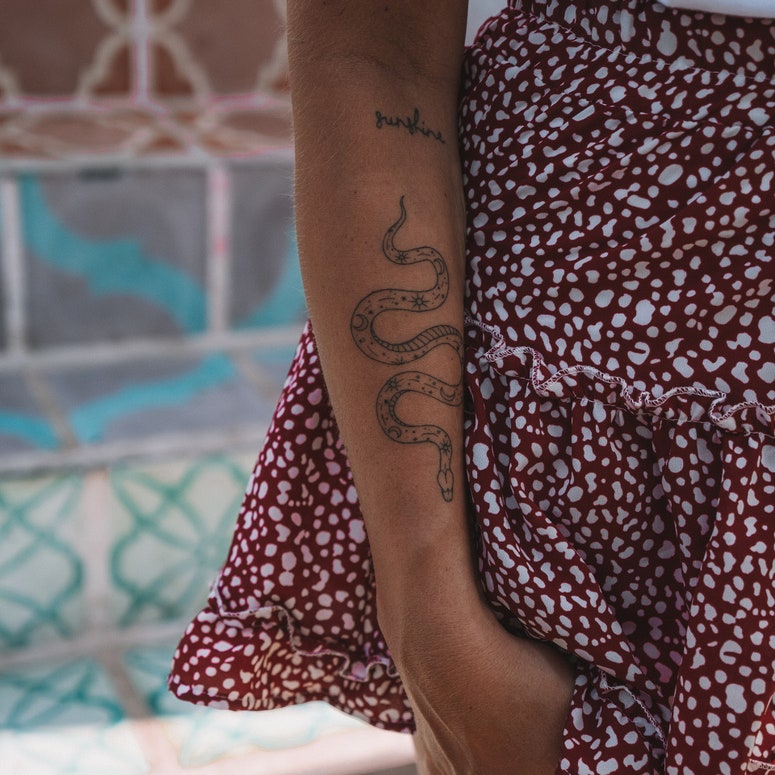We love tattoos, but the commitment can feel a bit intimidating. Most of us know a couple of mates who got some whacky quote inked onto their butt after losing a dare at uni. We might even have some teen tattoo regrets of our own. Even so, you can’t beat the spontaneity and thrill of getting inked – for many, it’s a right of passage. But what if there were a way to join the club without it being permanent?
Ephemeral, a tattoo studio in Brooklyn, New York, is paving the way, after pioneering the technology for tattoos that disappear after about 9 to 15 months. They don’t want you to confuse them with “temporary tattoos,” however. “Our ink is real tattoo ink that’s applied by real tattoo artists,” explains Ephemeral’s co-founder, Josh Sakhai. “It works just like any other tattoo ink, so artists will use their actual machine and equipment.” Instead, Sakhai and the rest of the crew refer to Ephemeral’s tattoos (which start at $175/£124 for small and simple designs, and $350/£248 for larger, statement pieces) as “made-to-fade.”

Ephemeral’s revolutionary ink took more than six years and 50 formulations to create. His co-founders (and uni besties) Vandan Shah and Brennal Pierre tapped their Ph.D.s in chemical engineering for the lengthy development process. The exact ingredients are top secret, but Sakhai reveals the black ink is composed of “medical-grade bioabsorbable and biocompatible polymers ” with “high-quality pigments.” Over time, the ink breaks down and the particles become small enough to be eliminated by the body, leaving your skin tattooless once again.
According to experts, this shop is doing something that’s pretty much unheard of. Roy Geronemus, a dermatologist and the director of Laser & Skin Surgery of New York says that some of the closest technology to the ink he has seen is henna, which typically fades after one to two weeks like other temporary tattoos, as well as the ink used in microblading, which typically lasts for a year. He hasn’t encountered Ephemeral’s semi-permanent ink, though.

Currently, Ephemeral’s ink is only available in black, and the artists recommend picking art that doesn’t require shading to ensure that your tattoos fade as evenly as possible. There aren’t any immediate plans for color ink, but Sakhai says it’s all up to the studio’s clients. “We started off with black ink simply because that’s what people wanted,” he says. “If we hear from our clients that [they] want color, we will make color.”
Additionally, the hands or feet aren’t recommended as locations for the tattoos because both areas tend to fade more quickly, even with traditional ink. In general, the tattoo artist will work with you to ensure your body art is placed in the optimal spot.
Unfortunately, the made-to-fade ink doesn’t lessen the pain of getting a tattoo. Though the ink is next-gen, the needle machine is the same one that’s used for traditional tattoos.

The main issue that Geronemus anticipates with Ephemeral tattoos is the potential for disappointment as the tattoo begins to vanish. “As it fades, it’s going to look washed out, which may not be necessarily appealing,” he says. But in the event that someone wants to remove the semi-faded tattoo even quicker, Geronemus has faith that laser removal will work just fine with Ephemeral’s ink.
Tina Alster, a board-certified dermatologist and founding director of the Washington Institute of Dermatologic Laser Surgery, is a bit more hesitant about Ephemeral’s ink and warns of potential scarring or allergic reaction to tattoos. Though the risk for both is small, she says people should be aware it’s still possible with made-to-fade as well as traditional tattoos. But with black ink, in particular, the risk is actually pretty rare, according to Geronemus. Make sure to follow your tattoo artist’s aftercare advice, and contact a board-certified dermatologist if you’re worried about a possible infection or reaction.

Most of all, Ephemeral’s ink allows people to flex their creativity with tattoos, knowing they will decorate their skin for only about a year. Without a lifelong commitment, you can take a bigger risk with daring body art. We just need to convince them to come to the UK.





